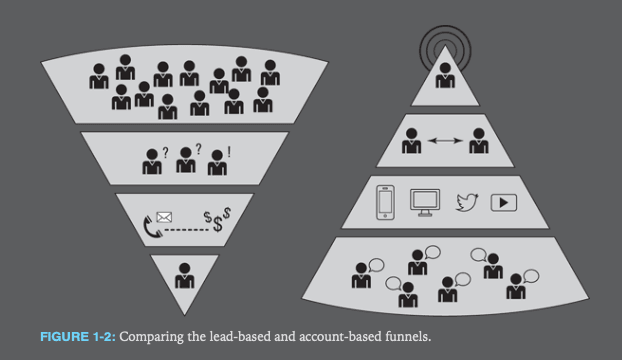ABM: Account-Based Marketing

A good definition for ABM (Account-Based Marketing) will always start with the hashtag #flipthefunnel. Accenture created the ABM method, also known as Account-Based Marketing, in 2002. It challenges the notion of ‘lead’ and is based on the premise that the sales funnel should be turned upside down.
Definition of Account-Based Marketing (ABM)

With ABM, the starting point is no longer a long list of prospects you wish to turn into customers. On the contrary, it starts with a shortlist of named accounts (ICPs or Ideal Customer Profiles). The idea is to grow your business within these accounts through the use of well-customised and targeted content.
The ABM approach, therefore, involves rethinking one’s content marketing strategy, in particular by repurposing content to support the business.
Defining the #flipthefunnel sales (and marketing) approach
ABM, therefore, goes against the grain of standard lead generation approaches (aka inbound marketing). Inbound marketing methodologies are suitable for B2C sales (one product, one salesperson, one customer) or B2B mass markets (e.g. office supplies sales).
But for other types of B2B sales, those involving complex sales processes, hard-to-sell products and services, and a high number of decision-makers, inbound marketing is most unsatisfactory. Inbound approaches often cause misunderstandings between marketing and sales teams in this context.
ABM and the Need for Sales and Marketing Alignment
ABM is mainly practised in the context of complex sales aimed at large accounts whose decision processes (read our definition of B2B buyer behaviour) are lengthy and involve many decision-makers.
Implementing an ABM strategy also imposes sales and marketing alignment. Sales and marketing must therefore focus on a list of target customers, also known as ICP (Ideal Customer Profiles)
Marketing needs to work with sales teams to create adequate content.
Where is ABM going?
B2B complex sales often involve 5 to 10 people within a company and one must have to convince each one before a sale is made. One also has to maintain a relationship with all of them in the long term.
Data marketing technologies are also very helpful for marketers and salespeople. to identify target decision-makers within the key account list.
Theoretically, ABM implies one sends personalised content or messages at the right time and to the right people to lead to a fruitful business relationship with the target decision-makers.
Predictive B2B scoring solutions also make it possible to analyse visits to a given website, i.e. what businesses visit your web assets.
Definition of ABM: Tools and Methods
Here are the main steps in the ABM process:
- First, you have to define your Ideal Customer Profiles (ICP). This step may be based on existing market studies as well as your sales and marketing assumptions.
- The next step is to define personas for your target accounts. Personas should be based on business-related criteria exclusively.
- The third step is about content production can begin once the target accounts have been identified and their organisational charts have been analysed. According to ABM theory, this content should not be generic but fully customised for a particular account.
- Finally, the promotion and distribution stages of this ultra-targeted content can begin.
In-depth Definition of ABM and Other Resources on the Subject
ABM (Account-Based Marketing): Amazon Book Options
The Account-Based Marketing as seen by Forrester
ABM: Complete guide for beginners



